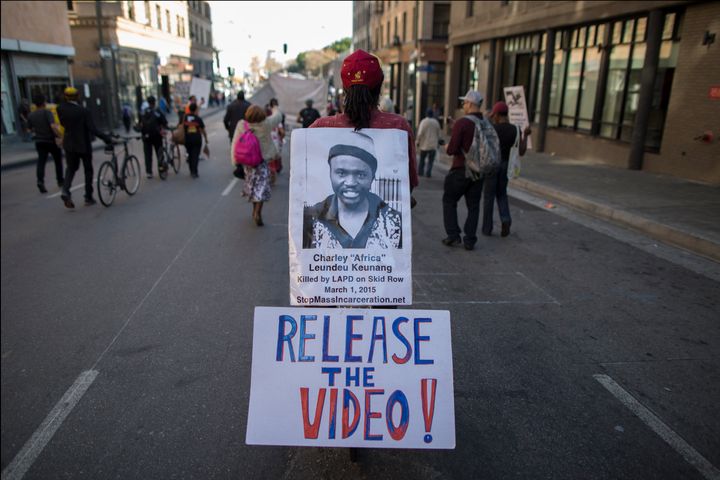
LOS ANGELES -- When police killed Charly Keunang, a homeless man, last March, it sparked protests and ignited another round of debate about the Los Angeles Police Department's use of deadly force. A video recorded by a witness to the fatal shooting called into question the official narrative that Keunang had reached for an officer's holstered gun as the two grappled on the ground, leading other nearby officers to open fire.
On Tuesday, the Los Angeles Police Commission, a civilian body that oversees the LAPD, moved to put an end to those questions -- without actually answering them. The board agreed with the police account, finding that the actions of the officers who killed Keunang were "in policy."
Keunang, a 43-year-old Cameroonian immigrant who was known as "Africa" in Skid Row, was shot six times, including twice in the chest. He was not armed.
The commission's ruling described body camera footage of the incident, saying it showed Keunang's hand "holding onto" the officer's gun as it was "substantially removed" from the holster. But the ruling was not accompanied by release of those videos, which were recorded by cameras worn by two officers on the scene.
The LAPD and the civilian commission both told The Huffington Post that there is no plan to release the videos in the future. In effect, the public will yet again have to take the police at their word.
The decision not to release critical footage in this case underscores broader concerns about the efficacy of body cameras. Law enforcement agencies across the country have begun adopting the equipment for the stated purpose of fostering transparency. If they're permitted to suppress video when it's potentially damning to police, however, many critics argue that transparency comes with an asterisk.
"LAPD's refusal to release the body-worn video footage seriously undercuts the Department's credibility and makes it seem like they have something to hide," said Peter Bibring, director of police practices at the American Civil Liberties Union of Southern California. "If the video so clearly shows the officer acted properly, they should release it."
He added, "Of course, the department should release video of shootings and other serious uses of force regardless. When police kill a civilian, the public deserves to judge for themselves what happened and whether officers' use of deadly force seems appropriate to the communities' standards."
While the body camera videos in Keunang's case have not been released publicly, a handful of journalists have reviewed the footage. Their observations suggest the recordings raise significant doubt about the officers' tactics and use of lethal force.
Jeff Sharlet wrote in a GQ story last year that the videos make a few things clear:
Charly does not have the gun, of this there is no question. He may have reached for it. His arm may have convulsed. He may have never come near. [LAPD Officer Joshua] Volasgis will tell the detectives he was straddling the suspect, by which he means his right hip — his gun — was close, or close enough to Charly's hand. He will insist that the suspect had "defeated" the two safety measures on his holster. He will say he was holding the suspect's hand down as the suspect attempted to draw his weapon. And yet, on [Sgt. Chand] Syed's and [Officer Francisco] Martinez's cam footage, we cannot see Charly reach. Volasgis will say the suspect lets go of his pistol only after the first shot is fired. But this is not true. When Martinez shoots Charly, Volasgis is already on his way to standing. The gun is beyond reach.
Reporters at the Los Angeles Times, who also reviewed the police video, said the footage showed Volasgis' gun still in its holster after Keunang was shot.
There are other recordings that the public has seen: surveillance video from a nearby building and cell phone video taken by an eyewitness. The latter begins with Keunang spinning toward a group of LAPD officers, arms flailing. One officer punches Keunang and tackles him to the ground, where the scuffle continues. Moments later, Keunang is dead.
But those videos were filmed at a greater distance than the body camera footage, and it’s difficult to discern what exactly is happening in the former.
LAPD Chief Charlie Beck has maintained that Keunang reached for the holstered gun and that his officers had no choice but to defend themselves. Not everyone is willing to trust him.
Before Tuesday's announcement, the Los Angeles Community Action Network, which focuses on issues affecting the city's low-income and homeless residents, had argued that the civilian commission was stalling on Keunang's case and even tried to keep it "under wraps."
Network members were in attendance when Matt Johnson, president of the police commission, announced its conclusion that the killing occurred "in policy."
The commission did cite Officer Volasgis for being "out of policy" in that he failed "to maintain control" of his pistol and baton.
Keunang's family has filed a $20 million wrongful-death lawsuit against the city of Los Angeles. Joshua Piovia-Scott, the family's lawyer, called for the LAPD to release the body camera videos if, as the police claim, they truly show the officers engaging in justifiable behavior.
By not doing so, the LAPD risks enhancing suspicions about its treatment of the city's most vulnerable populations and undermining public trust in its commitment to transparency.
"To the extent the public supports body cameras, they do so because they believe cameras will be used to provide transparency and hold officers accountable," said Bibring. "But body cameras don't provide transparency if the Department doesn't share the video with the public."